On November 20, 2024, the "MTS2025 Storage Industry Trends Seminar" and the inaugural TechFuture Awards 2024 ceremony co-hosted by TrendForce, the world's leading high-tech industry research institute and its subsidiary, Global Semiconductor Watch, were successfully concluded at the Raffles Hotel Perennial Shenzhen.
The event brought together heavyweights from the global memory semiconductor and terminal industries, TrendForce's senior analyst team, and thousands of elites from upstream and downstream companies in the industry chain. At the same time, the conference also attracted the attention and participation of more than 10,000 industry insiders online.
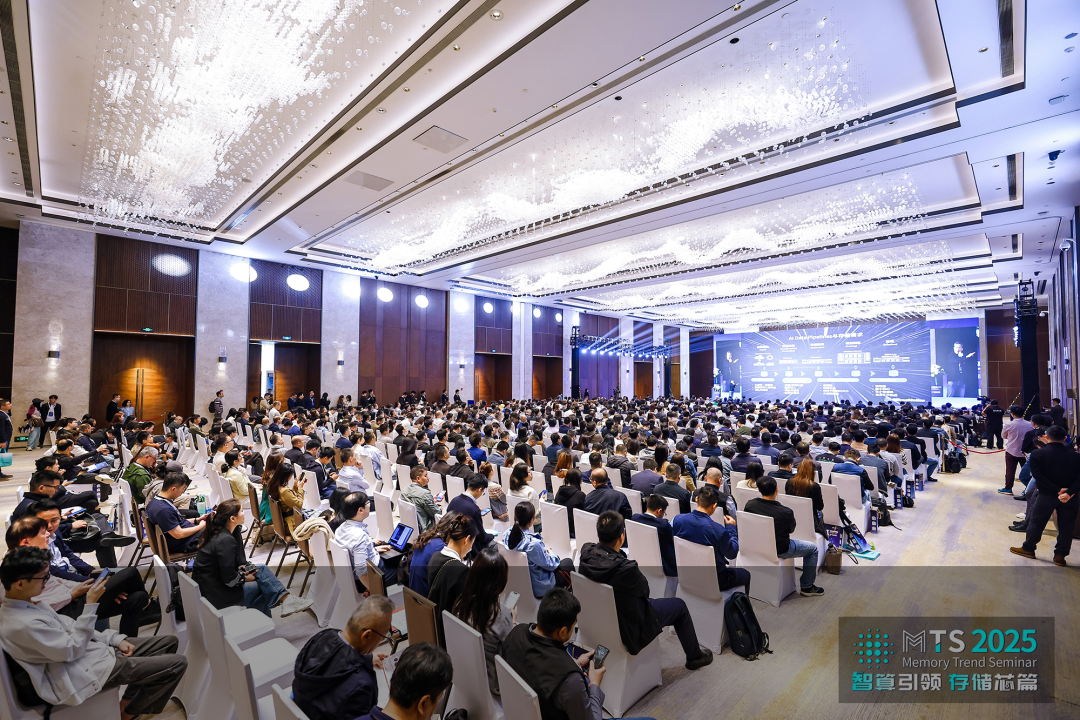
Figure: The scene of the MTS2025 Storage Industry Trend Seminar
At the beginning of the meeting, Dong Yunchang, Chairman of TrendForce Consulting (Shenzhen) Co., Ltd., delivered an opening speech. He warmly welcomed the guests and pointed out that despite the complex and volatile economic environment, the semiconductor and technology industries still have broad prospects thanks to the continuous pursuit of high technology and the vigorous development of AI. He hoped that the presentations would bring valuable insights to the guests, and thanked them for their continued support of TrendForce for more than 20 years.

Photo: Dong Yunchang, Chairman of TrendForce Consulting (Shenzhen) Co., Ltd
Next, TrendForce analysts and storage industry leaders delivered 12 speeches, the highlights of which are summarized below.
1. Guo Zuorong, Senior Vice President of Research at TrendForce
Topic: Dynamic Forecast of Wafer Foundry Industry in 2025 under the AI Storm
Mr. Guo Zuorong emphasized that in the past two years, the vigorous development of AI applications has continued to promote the surge in demand for high-performance computing chips, and high-computing power applications have become the main driving force for the continuous progress of advanced process technology and wafer foundry industry.
From 2025 onwards, this trend will deepen further. Not only AI chip vendors and CSPs (system-on-chip providers) are actively developing their own chips, but memory vendors are also actively responding to the demand for high computing power and seeking cooperation with advanced process foundry partners. This kind of inter-regional competition has profoundly changed the pattern of the global semiconductor industry, and in the future, both advanced technology and packaging technology will become the key factor determining the success or defeat of the competition.
At the same time, the supporting resources of the upstream, midstream and downstream of the fab, including IP (intellectual property), design services, and packaging and testing ecology, have also become an indispensable and important part of the competition in the AI field. In addition to the business opportunities brought by advanced processes, the industry is also paying attention to whether Edge AI (Edge Artificial Intelligence) can bring new vitality to mature processes that have been in sluggish demand for a long time. Driven by Cloud AI and Edge AI, how the foundry industry will evolve in 2025 has become the focus of the industry.
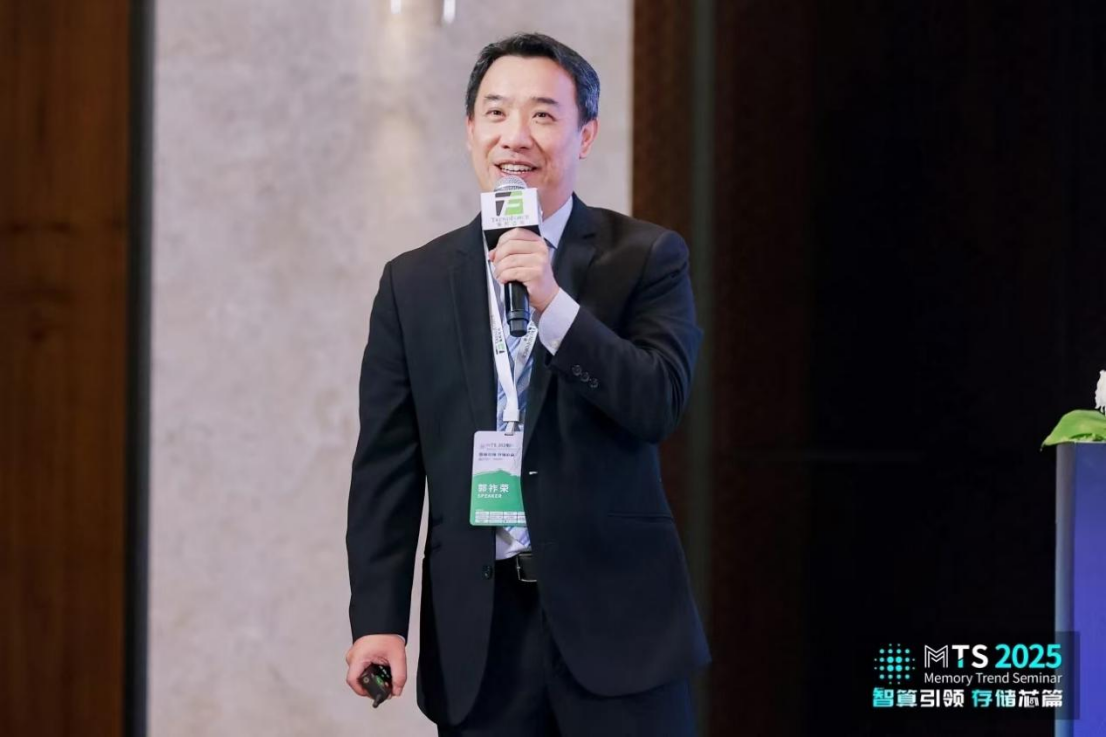
Pictured: Guo Zuorong, Senior Vice President of Research at TrendForce
1. Duan Xiting, senior vice president of CAS business group of Silicon Motion Technology
Topic: AI Data Efficiency, Key Storage Technologies
Mr. Duan explained that the wave of AI first emerged in data centers, and as it matured, this force began to flock to the edge side, covering a wide range of devices including mobile phones, automobiles, Internet of Things (IoT), robotics, and factory automation. Today, the cloud has five times as much storage capacity as the edge, but edge computing is growing twice as fast as the cloud. In addition, AI servers require 2 to 4 times more storage capacity than ordinary servers.
In the AI era, storage needs to have four core capabilities: first, high capacity, and at the same time, it needs to maintain a reasonable cost structure, so QLC NAND has attracted much attention in the industry; The second is data security, especially in the field of device-side AI, where data privacy protection, preventive measures, and data integrity have become the focus of AI development in the future. The third is data efficiency, including low latency, immediacy, cost savings, resource optimization, and data placement technology, which must be considered in the AI era. Finally, power efficiency, given the high power consumption of AI, how to reduce power consumption while maintaining efficiency is crucial.
To this end, Silicon Wing has launched a series of innovative technologies aimed at improving the high capacity, data efficiency, power efficiency, and data security of storage devices to meet the needs of the AI era. At the meeting, Mr. Duan Xiting introduced in detail the layout of Silicon Motion Technology in the AI storage ecosystem, covering four major areas: data center/enterprise storage, AI PC/mobile phone and smart car. Silicon Wing not only provides master control SoC solutions, but also enters various fields such as IoT devices, AI PC OEM, AI smartphones, global automakers, and data centers through partners.
Finally, Mr. Duan Xiting concluded that storage has always occupied a core position in the AI ecosystem, and capacity, data efficiency, power consumption, and security are the four key elements. Hybrid cloud is the future, and he encourages vendors in the storage industry to remain confident that the future is in their hands. Silicon Wing is willing to grow together with industry partners, join hands to enter a new era of AI, and help everyone move to a higher level.

Figure: Duan Xiting, senior vice president of CAS business group of Silicon Motion Technology
1. Ni Huangzhong, chairman of SCY
Topic: In the era of AI, the long-termism and marginal thinking of new storage forces
In 2024, the memory market will experience a dramatic "ice and fire" market: on the one hand, the consumer electronics market is weak, and the smartphone and laptop market is not in the peak season; On the other hand, the performance requirements of AI storage products have been greatly improved, driving the price of high-end storage products to continue to rise, and the demand for AI storage applications has increased significantly, indicating that the market will usher in a "prosperous scene" of diversified development next year.
In the context of market pressure in the industry, there has been chaos in the storage field, such as the rapid entry and exit of speculators and the disorderly expansion driven by capital. However, Mr. Ni Huangzhong pointed out that in the AI era, the storage industry has a huge market space, and new power manufacturers should uphold the spirit of long-termism, adhere to legal and compliant operations, increase R&D investment, and continue to introduce international advanced packaging and testing equipment to achieve sustainable development and ensure the forward-looking and leading R&D concepts and innovation capabilities, so as to meet the storage needs of future AI applications.
In the context of the AI era, SCY has strengthened its cooperation with the world's leading Memory Fab and first-class master control manufacturers, giving full play to their respective advantages, focusing on core businesses such as embedded, module and mobile storage, as well as mainstream storage applications, and is committed to becoming the world's leading provider of memory chips and solutions, and meeting the diverse needs of global customers with high-quality products and services.
At the meeting, Mr. Ni Huangzhong, on behalf of the company, officially released a new mass-produced high-performance embedded flash memory product - 1TB UFS 3.1, with sequential read and write speeds of up to 2100MB/s and 1700MB/s respectively, which can fully meet the storage needs of cutting-edge applications such as AI mobile phones and mainstream smart terminals. As a new landmark in China's storage industry, this comprehensive science and technology headquarters building integrating R&D, manufacturing and marketing is equipped with an internationally standardized 1,000-level dust-free intelligent manufacturing center and a cutting-edge technology joint R&D center, realizing the intelligent and digital construction of the whole building. With the full operation of the new production line, the overall production capacity will increase by more than 300%, and the annual output value of SCY is expected to exceed 10 billion yuan in the next 3-5 years.
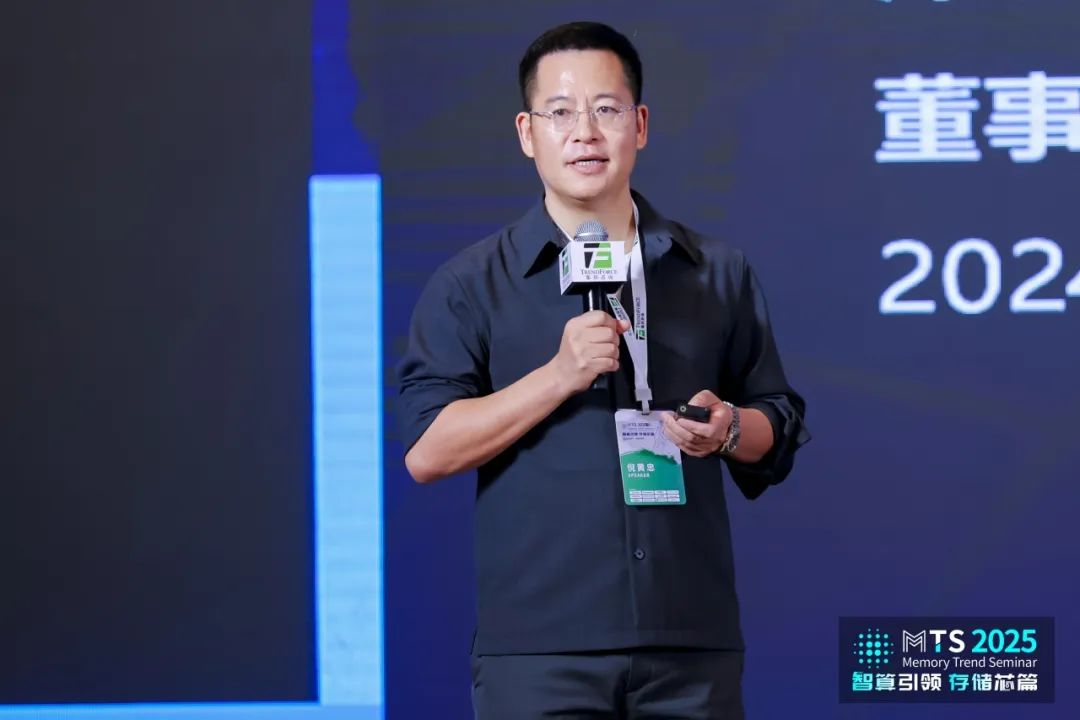
Pictured: Ni Huangzhong, chairman of SCY
1. Wu Yating, Senior Vice President of Research at TrendForce
Topic: Ice and Fire, Memory Industry Development Trends and Price Forecasts in 2025
Looking ahead to the DRAM market in 2025, Wu pointed out that the new production capacity of other mainstream DRAM suppliers will be relatively limited except in China, and the continuous expansion of HBM (high-bandwidth memory) reserved capacity will lead to a flat growth in the total production of traditional DRAM. If market demand meets expectations, TrendForce predicts that the prices of advanced process products such as DDR5 and LPDDR5x will remain stable, while DDR4 and LPDDR4x may face more significant price reduction pressure.
Next year, mobile DRAM production will be dominated by LPDDR5(X), reflecting the urgent need for high-performance and energy-efficient memory solutions. This demand is not limited to smartphones, but will gradually penetrate into the PC and AI fields.
In addition, with the continuous expansion of AI applications, the computing power and capacity of GPUs will be further improved. For example, NVIDIA's main product next year, Blackwell, is expected to be equipped with 192GB or 288GB of HBM3e memory, while AMD's MI325 will also be boosted to more than 288GB. This increase in capacity will further drive the market demand. From the supplier's point of view, despite the difficulty and cost of HBM's production, its high selling price makes the profit margins still lucrative. With the mass production and capacity expansion of HBM3e, its average selling price and revenue contribution are expected to increase quarter-on-quarter in the future. TrendForce believes that HBM3e may still face a tight supply situation by 2025.

Pictured: Wu Yating, Senior Vice President of Research at TrendForce
1. Gao Yu, General Manager of Intel China Technology Department
Topic: AI PC – Reshaping the PC Industry
Generative AI technology is gradually extending from the data center to the terminal side, indicating that the tool attributes of personal computers (PCs) are expected to be transformed into the ideal carrier of AI technology. In September 2023, Intel CEO Pat Gelsinger officially proposed the concept of "AI PC", followed by the release of the Core Ultra processor in December of the same year, marking Intel's continuous efforts to promote the landing and development of AI PCs.
Intel defines an AI PC as a computer powered by an Intel Core Ultra processor that integrates CPUs, GPUs, and new NPUs to bring users new or enhanced AI experiences in terms of productivity, creativity, and security. According to Mr. Gao Yu, the total computing power of the first-generation Intel Core Ultra family has reached 34TOPS, and the second-generation family has jumped to 120TOPS, indicating that the next-generation Core Ultra family will have more powerful AI processing capabilities.
With the increasing popularity of AI PCs, the performance and capacity requirements for memory products in the PC field will continue to rise, and AI PCs are expected to become an important force to promote the growth of the storage industry. Mr. Gao Yu pointed out that the memory configuration of the PC will be gradually expanded from the current 16GB and 24GB to 32GB, and may even use 64GB of memory in the future. At the same time, the importance of high-performance memory products such as DDR5 and LPDDR5 will also become increasingly prominent.
In addition to the improvement of hardware, the layout of the software ecosystem is also crucial to the development of AI PCs. Intel is actively working with AI model vendors, PC original equipment manufacturers (OEMs), and third-party software vendors to ensure that these models and software take full advantage of Intel's CPUs, GPUs, and NPUs for deeper optimizations to provide users with a better experience.
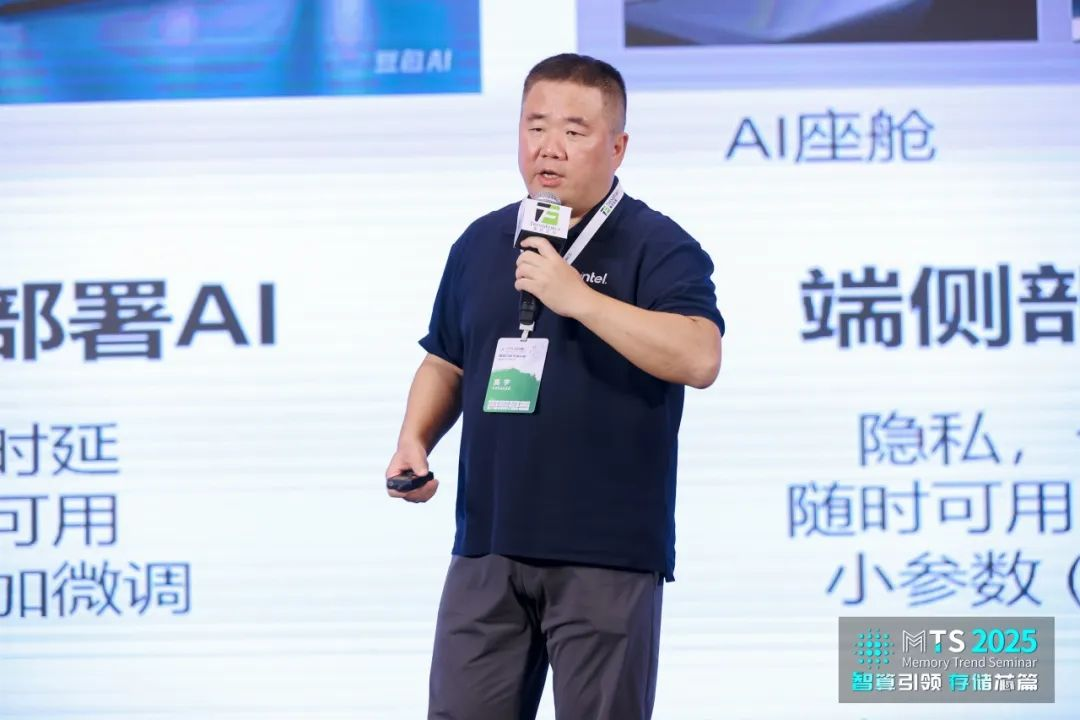
Pictured: Gao Yu, General Manager of Intel China Technology Department
1. Jinfeng Ni, Vice President of Sales, Asia Pacific, Solidigm
Topic: Efficient Storage: Embracing AI
Mr. Ni Jinfeng pointed out that artificial intelligence is profoundly changing all walks of life, and the storage field, which is the cornerstone of AI, is also undergoing fundamental changes, and the importance of efficient storage is becoming more and more significant. In order to meet the demand for storage capacity and many challenges including power and space constraints, the industry is actively developing high-capacity, energy-efficient SSDs.
Driven by AI, the advantages of QLC SSDs are becoming increasingly prominent. Compared with HDDs, QLC shows significant advantages in terms of capacity density, performance, reliability, and energy efficiency. Its powerful storage performance not only improves the efficiency and reliability of AI development, but also effectively saves power and rack space. QLC replacing HDD has become the general trend, this trend is not only reflected in the active embrace and promotion of QLC by more and more enterprises, but also reflected in the surge in demand for large-capacity QLC SSDs by regional AIGC users, which has exploded rapidly since the beginning of the year, greatly accelerating the expansion of the total QLC SSD market.
Solidigm is committed to providing comprehensive end-to-end storage solutions for the AI era, and its rich SSD product line can meet the diverse needs of different AI workloads. Solidigm has long been committed to the investment and layout of QLC field, especially high-capacity QLC SSD. Since 2018, Solidigm has shipped more than 100 exabytes of QLC products, and its QLC SSD portfolio covers multiple different capacity options.
Recently, Solidigm announced the launch of the 122TB Solidigm™ D5-P5336 data center SSD, which dramatically improves energy efficiency and space utilization, and delivers industry-leading storage efficiency for a wide range of use cases from the core data center to the edge. The all-new D5-P5336 offers twice the storage space and five years of unlimited random write endurance compared to the 61.44TB version already available in the industry. In addition, it supports a wide range of form factors and is compatible with industry-standard storage servers. Solidigm has already started sampling to customers and plans to be fully available in the first quarter of next year.
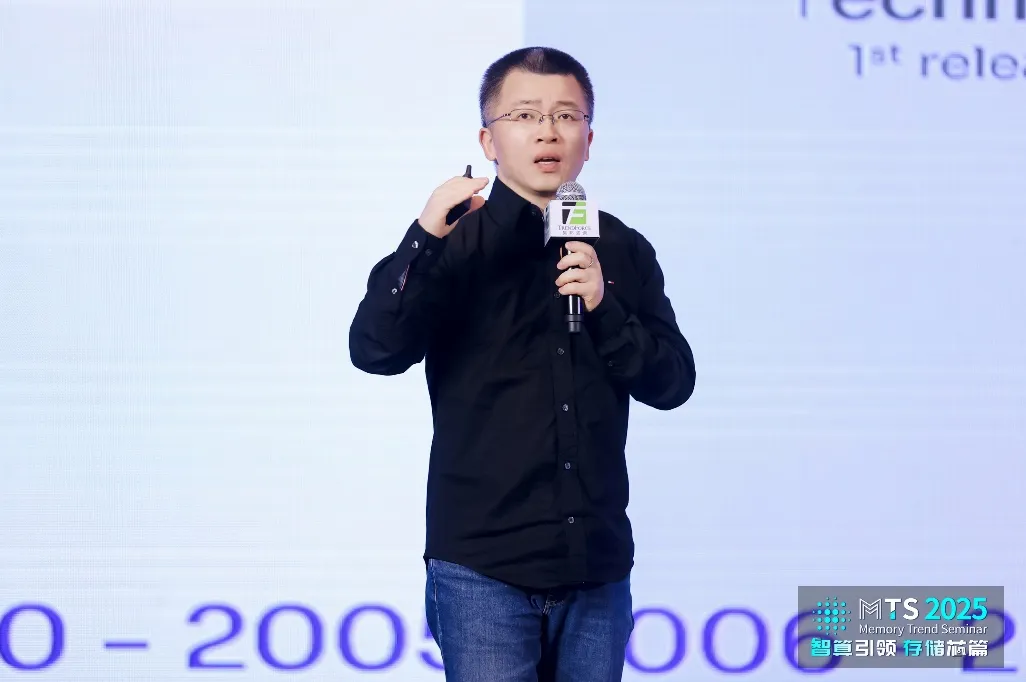
Pictured: Ni Jinfeng, Vice President of Solidigm's Asia Pacific Sales
1. Huang Shaowa, chairman of Quanxing Technology
Speech Theme: Convergence of Storage and Computing, Opening a New Chapter in the Era of AI for Quanmin
The training and inference process of large model AI is highly dependent on the memory capacity, and the solutions on the current market generally use multi-card parallel connection to improve computing power to meet the challenges of large data volume models. However, this approach faces the high cost, difficulty of acquisition, complex maintenance, and high power consumption of high-end graphics cards, which seriously hinder the local deployment and popularization of AI technology.
With more than 20 years of deep accumulation and technical exploration in the industry, Quanxing Technology has accurately grasped the development trend of the industry and innovatively launched Tianyi AI expansion card products. This product successfully breaks the limitation of video memory, expands the GPU memory capacity by 10 to 20 times, significantly reduces the cost of model training, solves the pain points of the industry, and makes it easier and feasible to deploy AI applications locally, thereby increasing the popularity of AI technology.
The AI Tianyi storage and computing integrated solution, which is composed of core hardware components such as "Quanxing Tianyi AI expansion card, enterprise-level SSD, and server memory", as well as Quanxing Technology's self-developed AI application software, only needs 10% of the market cost, and the power consumption is as low as 2KW, which can provide an integrated solution for training and inference for 70B ultra-large models. This solution truly achieves the goals of low cost, low energy consumption, localized deployment, data security, and flexible adaptation in multiple scenarios, and provides strong support for enterprises to realize the application of ultra-large models.
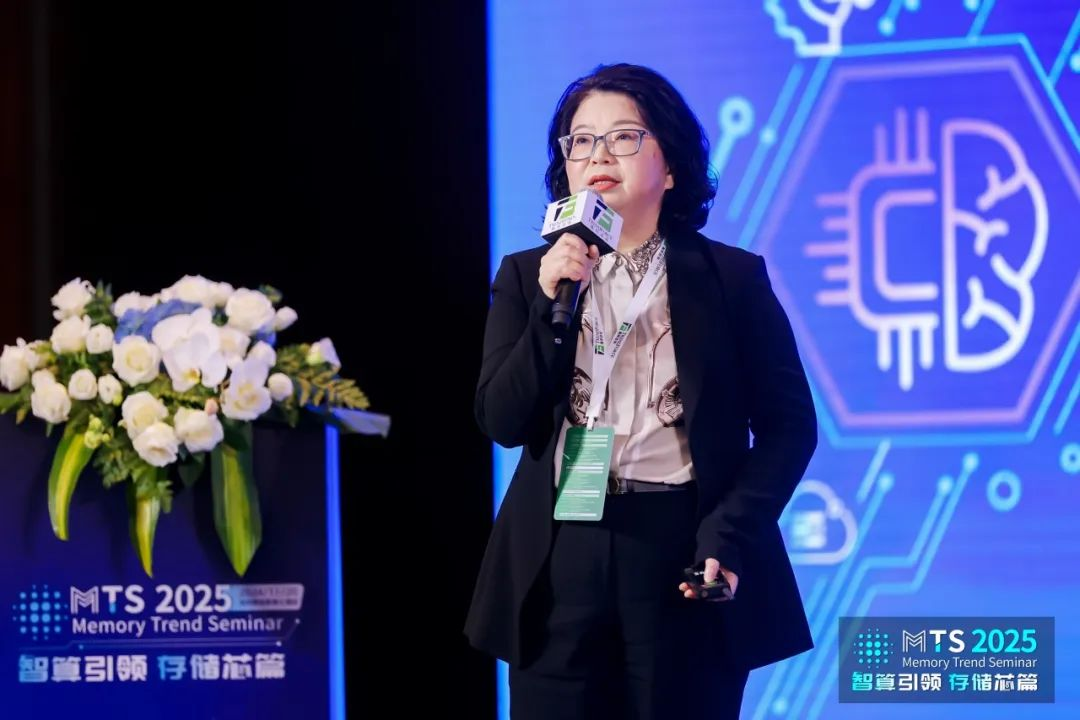
Picture: Huang Shaowa, chairman of Quanxing Technology
1. Wang Jinqiang, Director of DapuStor Corporation
Topic: Building a Powerful Foundation for AI Large Model Applications
In the era of AI, SSD technology has ushered in unprecedented challenges, especially in the training phase. Since the amount of data in the training set can be as high as tens of terabytes or even larger, far exceeding the capacity of the GPU's on-chip memory, it is necessary to store the data on a high-performance storage device and split the dataset to improve the efficiency of data loading, so as to make full use of the computing resources of the GPU. At the same time, in order to optimize the GPU's access to data, the AI training program uses a large number of parallel tasks, resulting in a much higher number of I/O requests than traditional CPU applications. I/O optimization schemes such as GDS/BaM shorten the I/O path, but also further increase the I/O pressure on the SSD.
In response to the demand for large-capacity and high-performance storage products proposed by AI, DapuStor provides a one-stop enterprise-level storage solution, which has the characteristics of high energy efficiency, high density, high reliability, cost advantages, and data security. The products cover interface standards from PCIe 3.0 to PCIe 5.0, from SLC to TLC, and even QLC storage media, and the specifications support U.2, E1. S、E3. S and other form factors, with capacities ranging from 1TB to 64TB.
As one of the earliest manufacturers in China to invest in enterprise-level QLC solutions, DapuStor focused on its J5000/J5060 QLC SSD series at the meeting. Among them, the J5000 series is the earliest QLC enterprise-class SSD launched in China, with a capacity of 15.36TB. In September this year, DapuStor released the J5060 QLC SSD series, with a maximum capacity of 61.44TB. In the long-term planning in the future, DapuStor will aim for higher capacity QLC SSDs, such as 128TB, 256TB and even 512TB.
In addition, Mr. Wang Jinqiang also introduced the PCIe 5.0 Roealsen® R6 series and PCIe 5.0 Haishen5 series products. Among them, the Roealsen® R6 series adopts the PCIe 5.0 main control chip DP800 developed by DapuStor, which has industry-leading random read and write IOPS, latency, and QoS performance, which can meet the needs of massive data storage in data centers, cloud computing and other scenarios.

Picture: Wang Jinqiang, Director of DapuStor Solutions Department
1. Wei Jian, general manager of Inspur Information Product Solution Development Department
Topic: Intelligent Computing Leads System Innovation
Ms. Wei Jian's speech focused on the needs and challenges brought by the development of artificial intelligence to IT infrastructure, as well as the coping strategies adopted by Inspur Information.
She emphasized that artificial intelligence, as a new type of productivity, has profoundly changed the world. However, the application and innovation of AI also faces multiple challenges, including the explosive growth of computing power demand accompanied by high energy consumption and low computing efficiency, high hallucination rate and low scaling efficiency of large models, the scarcity of high-quality data, and the discreteness of the ecosystem and the complexity of technology.
In order to meet these challenges, Inspur Information has proposed three major initiatives: full-stack innovation, data-driven and industrial collaboration. In terms of full-stack innovation, Inspur Information improves model accuracy and reduces computing power requirements through algorithm innovation; Achieve global optimization of computing, storage, and network through system optimization; And implement the concept of green energy saving to reduce system energy consumption. In terms of data-driven, Inspur Information adopts the meta-brain enterprise intelligence all-in-one machine to activate enterprise data and accelerate the implementation of innovative applications. In terms of industrial collaboration, Inspur Information actively advocates the concept of open hardware and open software, and works with partners to build a meta-brain ecology and accelerate the promotion and implementation of AI applications.
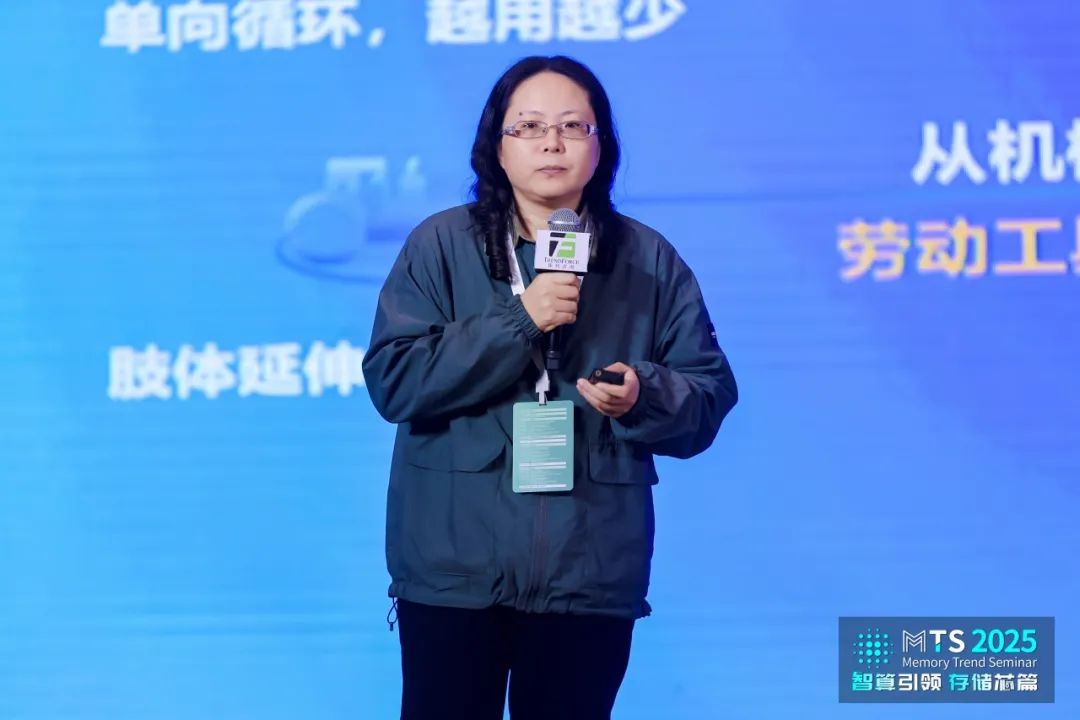
Figure: Wei Jian, general manager of Inspur Information Product Solution Development Department
1. TrendForce Research Manager Liu Jiahao
Topic: AI reshapes the future computing landscape, analysis of the server market and industry chain in 2025
Mr. Liu pointed out that TrendForce has observed that the server market is expected to recover next year, which is not only due to the demand for servers for new data center operations, but also to the significant support of the demand for new DDR5 platforms. As the global AI server market continues to grow in demand for AI infrastructure from cloud service providers (CSPs) and brand manufacturers, shipments of AI servers (including accelerators such as GPUs, FPGAs, and ASICs) are expected to climb to about 15% by 2025.
In terms of AI chip supply, NVIDIA's demand for high-end AI chips is expected to be particularly strong in 2025, among which the new generation of Blackwell platform equipped with high-bandwidth memory (HBM) is expected to become the mainstream of the market. The chip series under this platform covers pure GPU products (such as B200 and B200A) and the GB200 series integrated with Grace CPU, aiming to meet the needs of different customers such as CSPs and OEMs through more diversified AI server configurations. In addition, AMD, Intel and other vendors, as well as some CSPs, are also actively developing a new generation of AI software and hardware solutions, which is expected to drive double-digit year-on-year growth in AI server shipments in 2025, and drive the further development potential of related supply chains (including CoWoS packaging technology, HBM memory, thermal components, etc.).
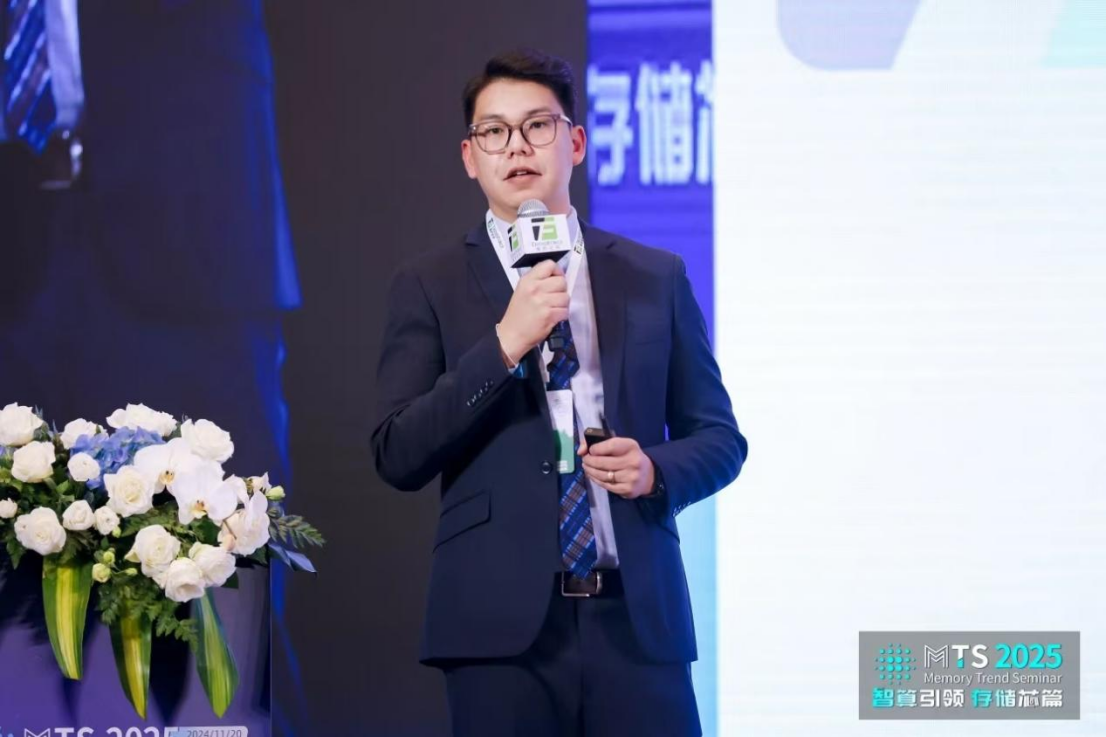
Pictured: TrendForce's Research Manager, Liujiahao
1. Zhao Ming, general manager of O'Connor Technologies
Topic: Testing Technology: The Engine for the High-Quality Development of the Storage Industry
As a key part of the back-end of the industrial chain, memory testing plays a vital role in enhancing the competitiveness of domestic storage manufacturers. With the continuous advancement of AI technology, the improvement of memory performance, power consumption control and stable operation have become the focus of market attention, and the requirements for memory testing technology have also increased.
Taking the SSD field as an example, Mr. Zhao Ming pointed out that high-quality SSDs need to go through multiple links such as R&D function verification testing, quality reliability testing, and mass production consistency testing, and form a closed loop of continuous improvement and upgrading of product quality through intelligent analysis of test data in each link.
However, at present, the traditional method is still commonly used for SSD testing in China, which has problems such as error-prone, high cost, limited production capacity, and difficult quality assurance. With 13 years of experience in the development of memory test systems, O'Connor has achieved complete independent research and development of test systems from HDDs to SSDs to NAND chips, providing a solid guarantee for the improvement of memory quality.
At the conference, Mr. Zhao Ming showcased Oconor's domestically produced GA300 series SSD test system (PCIe GEN5) and SW400 series RDIMM (DDR5) test system, and previewed the new generation of SSD Gen6 test system to be launched next year. These products are designed to compete with international competitors and meet the higher standards of performance and quality for enterprise and high-end users.

Pictured: Zhao Ming, general manager of O'Connor Technologies
1. Guofeng Ao, Research Manager at TrendForce
Topic: Analysis of the Flash Memory Industry: How to Respond to Market Opportunities and Challenges in 2025
Mr. Ao Guofeng comprehensively analyzed the evolution of NAND industry strategy from three perspectives: supply, demand and the Chinese market. On the supply side, NAND Flash suppliers have adopted prudent capex strategies after experiencing industry turmoil in 2023, a change that is expected to have an impact on NAND Flash supply bit growth in 2025.
On the demand side, looking ahead to 2025, artificial intelligence will become the core engine of NAND Flash demand growth. TrendForce has made a detailed forecast of the demand for NAND Flash for AI smartphones and AI PCs, discussed how AI applications will drive the capacity and performance of NAND Flash, and paid special attention to the demand trend for high-capacity enterprise SSDs in the coming years, especially in the fields of data center, cloud computing, and edge computing.
As for the Chinese market, TrendForce conducted an in-depth analysis of the long-term development trends of various flash memory end products in China, discussed factors such as domestic policy guidance, the rise of local enterprises, and changes in market demand, and assessed the far-reaching impact of these factors on the layout of the global NAND Flash industry.
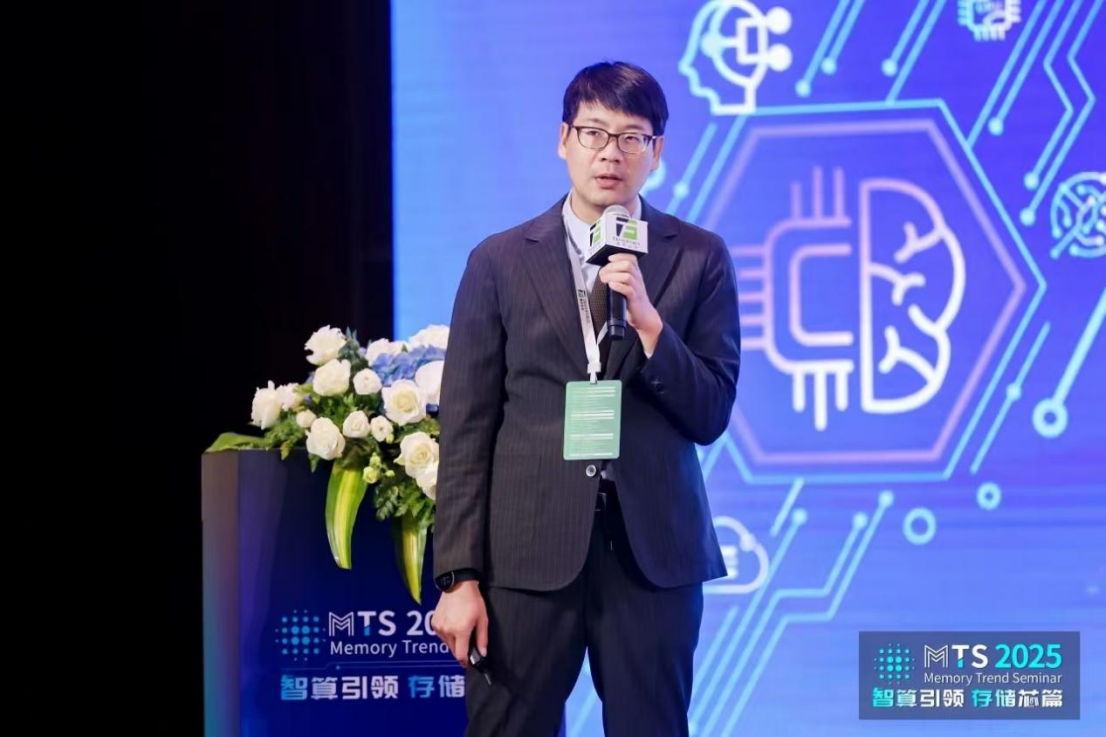
Photo: Ao Guofeng, Research Manager at TrendForce
During the conference, TrendForce also successfully hosted the inaugural TechFuture Awards 2024 ceremony. With rigorous data analysis, keen market insights, and accurate trend forecasting, TrendForce provides forward-looking research results for the industry and beyond, and helps enterprises make decisions. Based on the 2024 industry summary and the "2025 Top 10 Key Technology Sector Market Trend Forecasts", TrendForce presented honorary awards to outstanding companies in various fields for their outstanding contributions.
Wafer foundry field
Nexchip semiconductor Co., Ltd. won the "Wafer Foundry Outstanding Growth Award"
Memory field
Samsung Semiconductor won the "China Partner Gold Award"
Solidigm Wins AI Storage Solution Leadership Award
KIOXIA Wins Storage Technology Innovation Award
Western Digital Wins Product Performance Excellence Award
YMTTC won the China Flash Technology Pioneer Award
Server field
Foxconn Industrial Internet Co., Ltd. won the "Outstanding Contribution Award for AI Server Global Supply Chain"
Inspur Electronic Information Industry Co., Ltd. won the "AI Software and Hardware Platform Leading Award"
Wide bandgap semiconductor field
Infineon Technologies (China) Co., Ltd. wins the Future Power Electronics Technology Innovation Award
AI PC field
Intel (China) Co., Ltd. won the "AI CPU Global Influential Brand Award"
Near-eye display field
JBD Shine Display won the "Future Display Market Potential Award"
Semiconductor Integrated Display Technology won the "Future Display Rising Star Award"
Autonomous driving
SenseTime won the "China Autonomous Driving Research and Innovation Award"
Robotics
UBTECH won the "AI Robot Excellence Pioneer Award"

Figure: TechFuture Awards 2024 list
Thanks to the strong support of the speakers and the active participation and support of many companies such as SCY, Quanxing Technology, Solid State Technology, Solidigm, Kangying Semiconductor, DapuStor, Oconor Technology, Western Digital, DERA, Changjiang Wanrun Semiconductor, Silicon Motion Technology, and KIOXIA, the "TrendForce MTS 2025 Storage Industry Trends Seminar" and the inaugural TechFuture Awards 2024 Technology Future Award Ceremony have been successfully concluded. We are looking forward to seeing each other again in the future!
Related:
MTS2025 Storage Industry Trends Symposium: 12 Key Insights
Trendforce Predicts Wafer Foundry Industry will Grow by 20 Percent in 2025 Driven by AI Demand
Era of Multimodal AI,Silicon Motion Technology Analysis Four Key Storage Capabilities
SCY Ni Huangzhong: Long Termism and Marginal Thinking for Storage Enterprises in the AI Era






